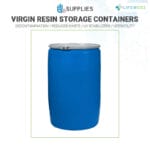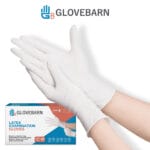What are Disposable Lab Coats?
Disposable lab coats are lightweight, single-use protective garments designed to safeguard workers in laboratory, healthcare, and industrial environments from contamination, spills, and exposure to hazardous substances. These coats are made from materials such as polypropylene, polyethylene, or other non-woven fabrics, providing a barrier against liquids, chemicals, and biological agents. Unlike reusable lab coats, disposable ones are designed for single-use and can be discarded after exposure to hazardous materials, reducing the risk of cross-contamination.
Disposable lab coats are commonly used in environments where cleanliness and hygiene are critical, such as laboratories, pharmaceutical manufacturing, food processing, and healthcare settings. They offer convenience, are cost-effective, and reduce the need for laundering and decontamination, making them a practical choice for environments with frequent contamination risks.
Why Disposable Lab Coats Matter in the Enterprise Environment
Disposable lab coats are essential for maintaining hygiene, cleanliness, and safety in industries where workers are exposed to hazardous substances or require protection against contamination. By providing a protective barrier, these lab coats help prevent the transfer of contaminants, protect clothing and skin, and reduce the risk of exposure to harmful chemicals or biological agents. Disposable lab coats also play a key role in ensuring compliance with safety regulations, particularly in industries like healthcare, pharmaceuticals, and food processing.
In the enterprise environment, using disposable lab coats can minimize cross-contamination between work areas and tasks. Since these coats are discarded after use, they provide a reliable solution for maintaining sterile conditions without the need for laundering or sterilization, which can be costly and time-consuming. Disposable lab coats also promote safety by ensuring that employees always have access to clean, uncontaminated protective clothing.
Benefits of Disposable Lab Coats
Disposable lab coats offer several advantages that make them suitable for various industries and applications. Key benefits include:
- Protection Against Contamination: Disposable lab coats act as a barrier against splashes, spills, and contaminants, preventing hazardous substances from coming into contact with workers’ skin or clothing.
- Single-Use Convenience: Since disposable lab coats are designed for single use, they eliminate the need for laundering or sterilization, providing a clean, fresh garment for each task or shift.
- Cost-Effective: Disposable lab coats are often more affordable than reusable alternatives, particularly in environments where frequent changes are required due to contamination risks.
- Reduced Risk of Cross-Contamination: By discarding the coat after use, workers reduce the risk of cross-contamination between tasks or areas, especially in healthcare, food processing, and cleanroom environments.
- Compliance with Safety Standards: Disposable lab coats help organizations meet industry-specific safety regulations, such as OSHA and FDA standards, by providing an additional layer of protection in hazardous work environments.
- Comfort and Breathability: Made from lightweight, breathable materials, disposable lab coats offer comfort during long shifts while still providing adequate protection.
Types of Disposable Lab Coats
There are different types of disposable lab coats designed to meet the specific needs of various industries. Common types include:
1. Polypropylene Lab Coats
- Purpose: Made from lightweight, breathable polypropylene fabric, these lab coats are ideal for use in environments where protection against dust, dirt, and light chemical splashes is required.
- Common Uses: Laboratories, cleanrooms, and light industrial environments.
- Features: These coats are often breathable, comfortable, and available with elastic cuffs, snap closures, or pockets for added functionality.
2. Polyethylene-Coated Lab Coats
- Purpose: Designed for environments where protection against liquids and light chemical splashes is needed, polyethylene-coated lab coats provide added resistance to moisture and chemicals.
- Common Uses: Chemical handling, food processing, and pharmaceutical manufacturing.
- Features: These coats are coated with a layer of polyethylene for enhanced protection against liquids and hazardous chemicals, making them more durable than standard polypropylene lab coats.
3. Flame-Resistant Disposable Lab Coats
- Purpose: These lab coats provide an added layer of protection against heat and flames, making them suitable for environments with fire or explosion risks.
- Common Uses: Laboratories, chemical processing, and environments with flammable materials.
- Features: Made from flame-resistant materials, these lab coats are designed to protect workers from fire hazards while maintaining comfort and flexibility.
4. Anti-Static Lab Coats
- Purpose: Designed for environments where static electricity poses a risk, anti-static disposable lab coats prevent the buildup of static charges that can damage sensitive equipment or ignite flammable substances.
- Common Uses: Electronics manufacturing, cleanrooms, and chemical processing.
- Features: These lab coats are made from materials with anti-static properties to reduce the risk of electrostatic discharge (ESD).
Regulatory Compliance for Disposable Lab Coats
Disposable lab coats must meet certain regulatory requirements, depending on the industry and specific hazards they are designed to protect against. Key regulations include:
- OSHA (Occupational Safety and Health Administration): OSHA requires employers to provide appropriate PPE, including lab coats, to protect workers from hazards such as chemical exposure, biological agents, or physical injuries. Disposable lab coats must meet OSHA’s PPE standards for the specific hazards present in the workplace.
- FDA (Food and Drug Administration): In healthcare and pharmaceutical environments, disposable lab coats must meet FDA standards for medical and sterile protective clothing. These standards ensure that lab coats used in medical or pharmaceutical settings provide adequate protection against contamination.
- NFPA (National Fire Protection Association): For environments where fire hazards are present, flame-resistant disposable lab coats must meet NFPA standards, such as NFPA 2112, which outlines requirements for flame-resistant clothing in industrial environments.
- CE Marking (Conformité Européenne): In Europe, disposable lab coats used in hazardous environments must comply with the PPE Regulation (EU) 2016/425 and display the CE mark, indicating that they meet European health, safety, and environmental standards.
Best Practices for Using Disposable Lab Coats
To maximize the effectiveness and safety of disposable lab coats, workplaces should follow these best practices:
1. Proper Disposal After Use
- Importance: Disposable lab coats should be discarded after use, particularly if they have been exposed to hazardous chemicals or biological agents.
- Action: Ensure that disposal bins are available in areas where disposable lab coats are used, and that workers are trained to dispose of them properly to prevent contamination.
2. Provide Appropriate PPE Training
- Importance: Workers need to understand how and when to use disposable lab coats to ensure proper protection.
- Action: Train employees on the correct use of disposable lab coats, including when to wear them, how to dispose of them, and how to select the appropriate type based on the task or environment.
3. Maintain Stock Levels
- Importance: Running out of disposable lab coats can leave workers unprotected in hazardous environments.
- Action: Ensure that sufficient stock of disposable lab coats is always available, and implement a restocking system to prevent shortages.
4. Ensure Proper Fit
- Importance: Ill-fitting lab coats may leave workers exposed to hazards.
- Action: Provide a range of sizes to ensure that disposable lab coats fit properly and offer full protection. Lab coats with adjustable closures or elastic cuffs may be preferable for ensuring a secure fit.
5. Match the Lab Coat to the Hazard
- Importance: Not all disposable lab coats provide the same level of protection, so choosing the right one is essential for worker safety.
- Action: Conduct a hazard assessment to determine the appropriate type of disposable lab coat needed for each task, whether it’s flame resistance, chemical protection, or anti-static properties.
The Role of Enterprise Software in Managing Disposable Lab Coats
Enterprise software solutions can help organizations effectively manage the use and distribution of disposable lab coats by:
- Inventory Management: Track the availability and usage of disposable lab coats to ensure that stock levels are maintained and automatically reorder supplies when necessary.
- Compliance Monitoring: Monitor compliance with OSHA, FDA, or other regulatory requirements for protective clothing in specific industries, ensuring that workers are using the correct type of disposable lab coat for the task.
- Training and Certification: Schedule and track employee training on the proper use and disposal of disposable lab coats, ensuring that workers are properly trained to handle hazardous materials.
- Waste Management: Track the disposal of used lab coats, ensuring that hazardous waste disposal protocols are followed in industries where contamination is a concern.
Conclusion
Disposable lab coats play a critical role in maintaining hygiene and safety in various industries, from healthcare to laboratories and chemical processing. By providing protection against contamination, spills, and hazardous substances, disposable lab coats help ensure that workers stay safe while performing their tasks. Proper use, disposal, and management of these lab coats are essential for minimizing cross-contamination and ensuring regulatory compliance. Enterprise software solutions can further enhance the management of disposable lab coats by tracking inventory, monitoring compliance, and scheduling training, ensuring that workers are properly equipped and protected.
« Back to Glossary Index

















